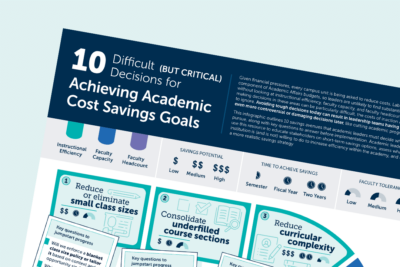Capture savings—without cutting programs
In hopes of reallocating resources toward strategic priorities, many college and university administrators look to cut or restructure less effective programs in order to rededicate funds to stronger ones.
But program cuts are politically difficult to carry out and rarely deliver substantial savings when they do happen.
The largest cost of running an academic program comes from tenured faculty, but few institutions are willing or able to eliminate those positions even when they shutter a program.
The most savings administrators can hope for from program cuts is the elimination of administrative staff and part-time faculty positions. But because programs take a long time to sunset, it can be years before institutions realize even these limited savings.
Recapture central funds from faculty lines
Instead of cutting academic programs, some institutions have found creative ways to centrally reallocate funds opened up when faculty retire. Indiana University-Bloomington has implemented a strategy to capture the savings that come from backfilling faculty retirements with less expensive junior faculty members.
Originally, when a faculty member making $120,000 each year retired, the academic department would keep all of the $120,000 to make a new hire. Under IU-Bloomington’s new faculty line recapture strategy, when a faculty member making $120,000 retires, the department keeps $80,000 to hire a junior faculty member and IU-Bloomington’s strategic fund collects $40,000.
Already, IU-Bloomington is seeing early returns from this approach. After more than 300 faculty and staff participated in an early retirement program, IU-Bloomington was able to capture $10 million for its central strategic fund in just two years.
-
$8.6M
Lump payout of income replacement and PTO
-
$2.6M
Annual cost of ongoing health benefits
More Resources

10 difficult (but critical) decisions for achieving academic cost
savings goals

Academic Innovation Resource Center
